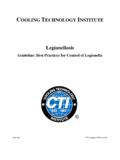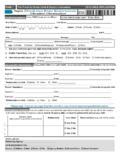Transcription of The CDC Guide to Strategies to Support …
1 Strategies to Prevent Obesity and Other chronic Diseases The CDC Guide to Strategies to Support breastfeeding Mothers and Babies National Center for chronic Disease Prevention and Health Promotion Division of Nutrition, Physical Activity, and Obesity For Free Copies Download E-mail Write The CDC Guide to Strategies to Support breastfeeding Mothers and Babies Centers for Disease Control and Prevention 1600 Clifton Rd. Atlanta, GA 30333. Call 1-800-CDC-INFO (1-800-232-4636); TTY: 1-888-232-6348. Suggested Citation Centers for Disease Control and Prevention. Strategies to Prevent Obesity and Other chronic Diseases: The CDC Guide to Strategies to Support breastfeeding Mothers and Babies. Atlanta: Department of Health and Human Services; 2013.
2 Web site addresses of nonfederal organizations are provided solely as a service to readers. Provision of an address does not constitute an endorsement of this organization by CDC or the federal government, and none should be inferred. CDC is not responsible for the content of other organizations' Web pages. Strategies to Prevent Obesity and Other chronic Diseases The CDC Guide to Strategies to Support breastfeeding Mothers and Babies Department of Health and Human Services Centers for Disease Control and Prevention National Center for chronic Disease Prevention and Health Promotion Division of Nutrition, Physical Activity, and Obesity ii Contents Using This 1. Introduction .. 3. Strategy 1. Maternity care 5. Strategy 2.
3 Professional 11. Strategy 3. Access to professional 15. Strategy 4. Peer Support 19. Strategy 5. Support for breastfeeding in the 23. Strategy 6. Support for breastfeeding in early care and 29. Strategy 7. Access to breastfeeding education and 33. Strategy 8. Social 37. Strategy 9. Addressing the marketing of infant 43. 47. iii iv Using This Guide This document provides guidance for public health professionals and others on how to select Strategies to Support breastfeeding mothers and increase breastfeeding rates. It offers the most relevant information on each type of strategy. The discussion of each strategy follows the outline defined here. Strategy Describes an environmental change or activity intended to prevent disease or promote health in a group of people, also referred to as an intervention or approach.
4 Criteria for inclusion of a strategy in this document are a rationale supporting the strategy and examples of implemented programs. Definition Briefly describes the strategy. Rationale Explains why the particular strategy is important to efforts to Support breastfeeding mothers and increase breastfeeding rates. Evidence of Effectiveness Draws on peer-reviewed literature and current practice to summarize the evidence of the strategy's effectiveness. Key Considerations Includes information that may be important to keep in mind during the planning, implementation, or evaluation phases of a strategy. Action Steps Identifies specific activities for each strategy that public health professionals can take to implement Strategies in specific settings, including communities, schools, child care facilities, work sites, and medical care facilities.
5 Program Examples Includes examples of programs that use the strategy as a way to Support and increase breastfeeding . Program examples were selected from interventions described in other publications, such as peer- reviewed journals or program reports, or identified by key informants and through Internet searches. Readers should review these examples for local applicability and evidence of effectiveness. Resources Guides the reader to additional materials and information that might be useful in planning, implementing, or evaluating the strategy. Many of the examples and success stories in this document reflect programs conducted by organizations outside of the Centers for Disease Control and Prevention (CDC) and the federal government without CDC or federal funding.
6 These examples are provided for illustrative purposes and do not constitute a CDC or federal government activity or endorsement. Readers should review these examples for local applicability and evidence of effectiveness. 1. 2. Introduction Research has shown that breastfeeding is professionals, and other organizations and recognized as the best source of nutrition for individuals can take to Support mothers and most infants. In 2007, the Agency for Healthcare make breastfeeding easier. Research and Quality (AHRQ) published a summary of systematic reviews and meta- This publication, Strategies to Prevent Obesity analyses on breastfeeding and maternal and and Other chronic Diseases: The CDC Guide to infant health outcomes in developed Strategies to Support breastfeeding Mothers and The AHRQ report reaffirmed the health benefits Babies, provides information on interventions of breastfeeding and the health risks associated and programs that address many of the steps with formula feeding and early weaning from called for by the Surgeon General.
7 These breastfeeding . Infants who are not breastfed interventions and programs also are designed to experience more episodes of diarrhea, ear meet many of the health objectives set forth in infections, and lower respiratory tract infections Healthy People 2020. This 10-year national health and are at higher risk of sudden infant death agenda provides a framework for health promotion syndrome, diabetes, and obesity. breastfeeding and disease prevention for the United States. It also helps protect mothers from breast and includes new objectives to increase breastfeeding ovarian rates and improve outcome measures specific to work sites and maternity care. To help Support breastfeeding mothers and increase breastfeeding rates in the United States, These objectives are in addition to CDC's ongoing the Surgeon General released The Surgeon goal of decreasing disparities in breastfeeding rates General's Call to Action to Support breastfeeding and increasing collaboration between partners at in 2011.
8 The Call to Action sets out clear action federal, state, and community levels to overcome steps that communities, health care systems, breastfeeding challenges. health care providers, employers, public health Healthy People 2020 Objectives Maternal, Infant, and Child Health (MICH) Objectives Baseline Target MICH 21: Increase the proportion of infants who are breastfed Ever At 6 months At 1 year Exclusively through 3 months Exclusively through 6 months MICH 22: Increase the proportion of employers that have work-site lactation Support programs MICH 23: Reduce the proportion of breastfed newborns who receive formula supplementation within the first 2 days of life MICH 24: Increase the proportion of live births that occur in facilities that provide recommended care for lactating mothers and their babies 3.
9 Many types of interventions have been implemented in the United States and in other parts of the world to try to increase breastfeeding initiation and duration, as well as exclusive breastfeeding . The Strategies described in this Guide focus on policy and environmental changes that are designed to increase Support for women who choose to breastfeed and to increase the number of women who choose to breastfeed. Strategies were selected on the best available evidence, as well as the knowledge and expertise of the authors and CDC partners, including breastfeeding experts and members of state breastfeeding coalitions. Because formal evaluation of breastfeeding interventions is not widespread, this Guide includes some practices and interventions that have not been formally evaluated but which have an established history of use or a strong rationale for use.
10 These Strategies are included because this Guide is intended to provide information reviewed journals, to increase the evidence base on all major types of interventions known to for breastfeeding interventions and help other have been implemented to promote and Support decision makers choose effective Strategies to breastfeeding . Support and increase breastfeeding . Some interventions have been shown to be This Guide is best used as an introduction effective when they were evaluated as components to the many interventions that have been of multifaceted interventions. CDC does not developed to protect, promote, and Support discourage the use of individual interventions breastfeeding . Readers can review the program with limited evidence of effectiveness, but examples, resources, and references or contact recommends that if they are used, they should the organizations involved for more information be formally evaluated before they are widely about specific interventions.















